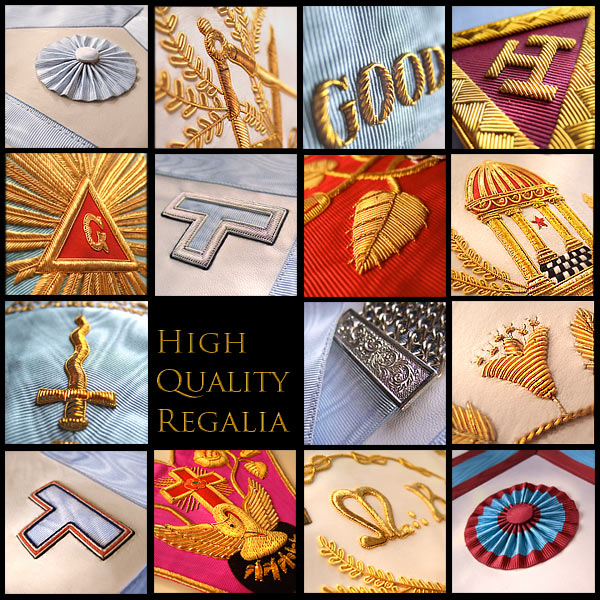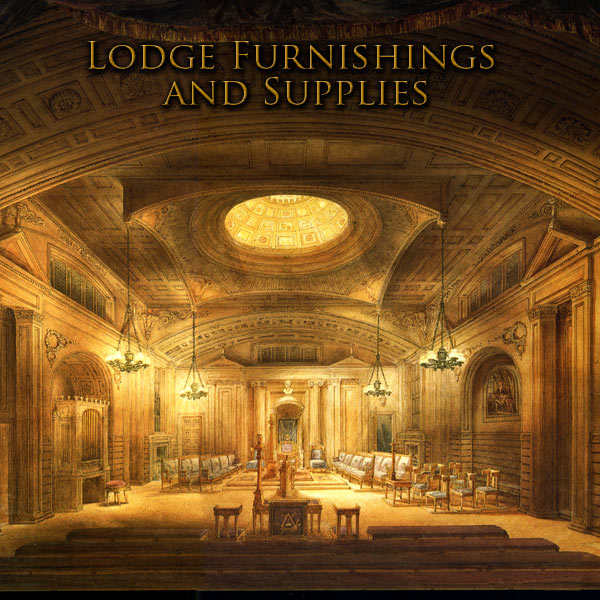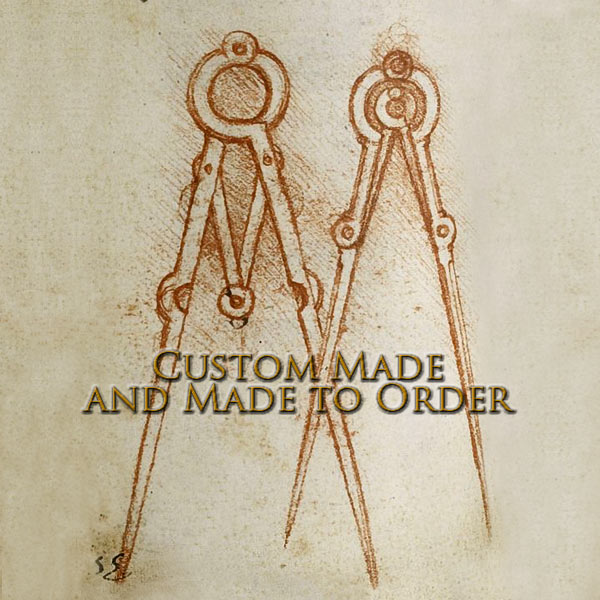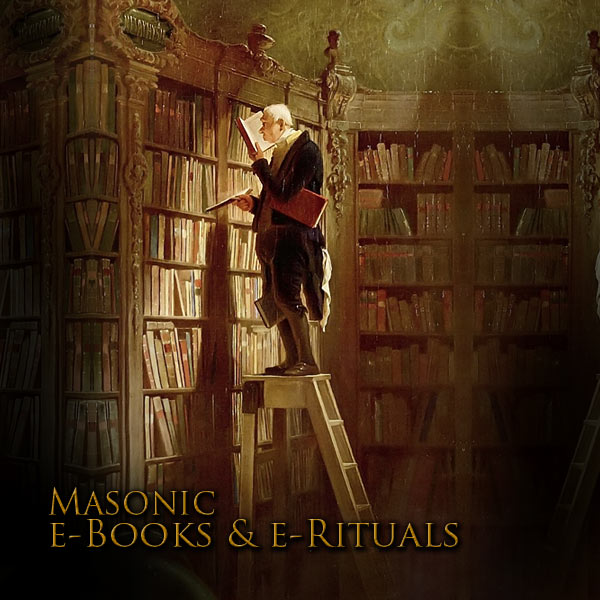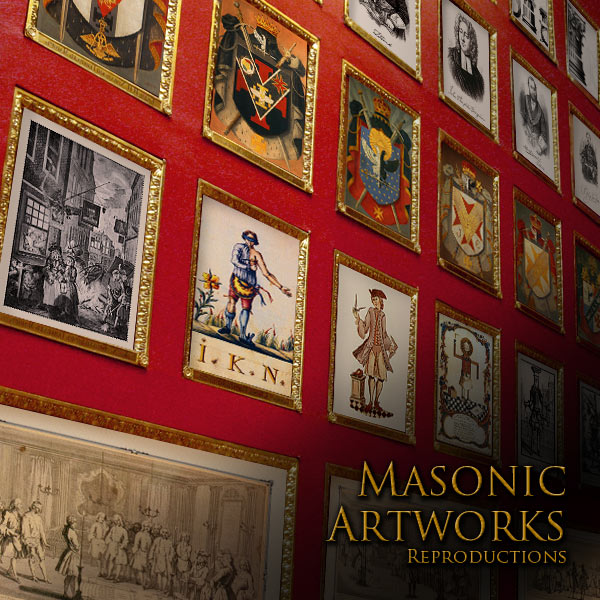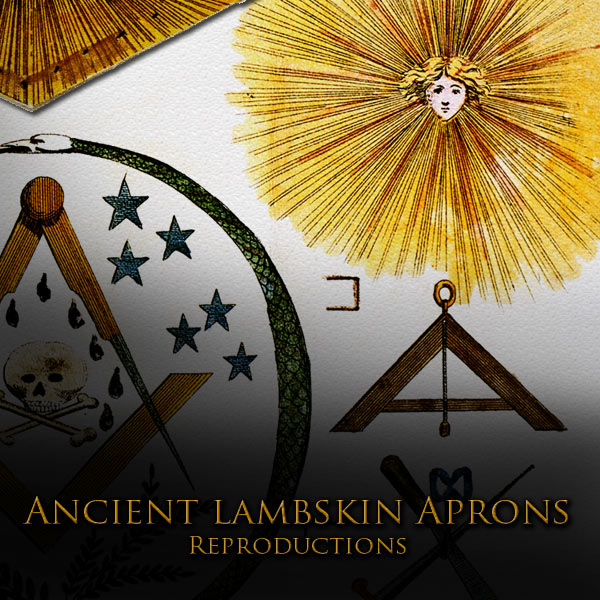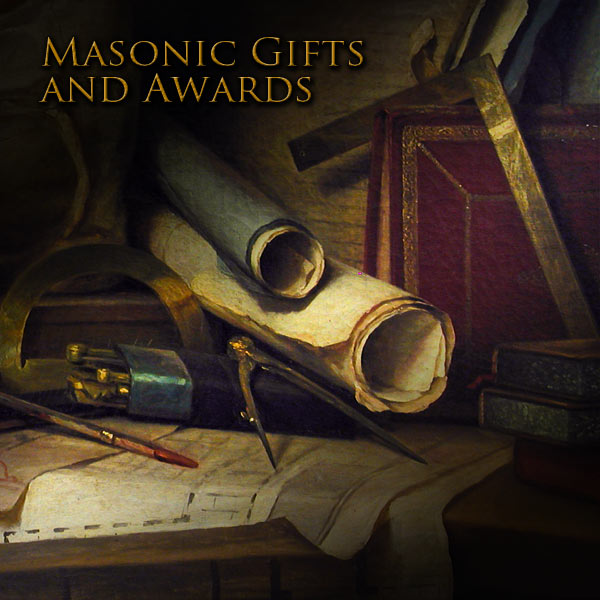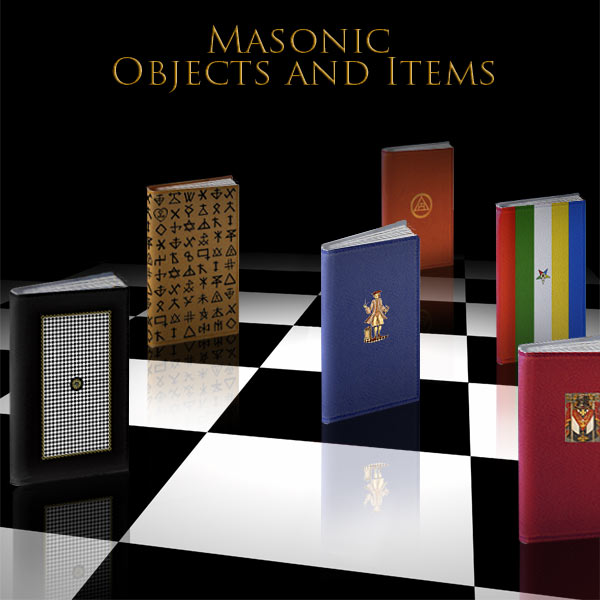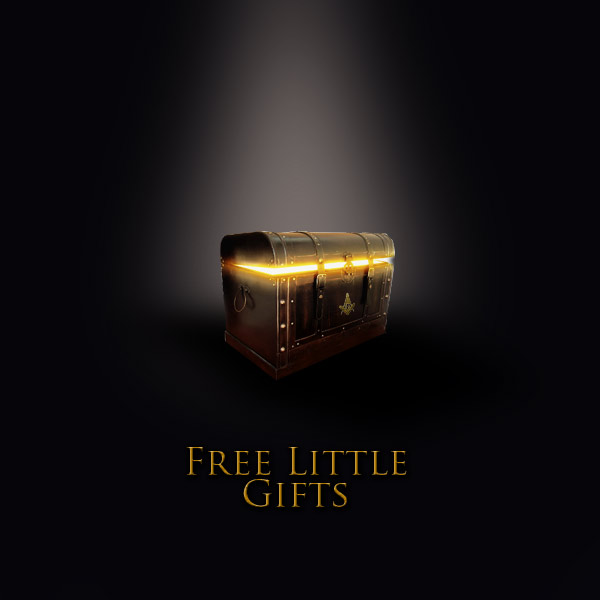Customer Services
Be welcome to contact us,
by Email, by Phone or by Skype…
....... UK (London): 0204 577 1717
9:00 am to 6:30 pm - Monday to Saturday
....... US (YORK-PA): (717)356-0727
8:00 am to 1:30 pm (ET) - Monday to Saturday
....... Intl: +33 952 42 49 61
8:00 to 17:30 GMT - Monday to Saturday
.....................
...............
![]()

NEW PAGE !
∴ SEE OUR CUSTOMER FEEDBACK PAGE
NEW REGALIA !
∴ SCOTTISH RITE 12° AND 14° DEGREES APRONS
∴ MARTINISM
∴ UK GRAND RANKS
PERSONALIZE YOUR REGALIA
YOUR NAME HAND EMBROIDERED ON YOUR APRON, YOUR SASH OR YOUR COLLAR
WE ARE LOOKING FOR...
REPRESENTATIVES
∴ SEE OUR CUSTOMER FEEDBACK PAGE
NEW REGALIA !
∴ SCOTTISH RITE 12° AND 14° DEGREES APRONS
∴ MARTINISM
∴ UK GRAND RANKS
PERSONALIZE YOUR REGALIA
YOUR NAME HAND EMBROIDERED ON YOUR APRON, YOUR SASH OR YOUR COLLAR
WE ARE LOOKING FOR...
REPRESENTATIVES
![]() Masonic e-Texts
Masonic e-Texts
![]()
A Lexicon of Freemasonry.
Albert G. Mackey.
Containing a definition of all its communicable terms...
Text in english
e-Text in Word or PDF format
$ £ € 8
More info...
A lexicon of freemasonryContaining a definition of all its communicable terms, notices of its history, traditions, and antiquities, and an account of the rites and mysteries of the ancient world.
Here is an extract of a definition:
ACACIA.
An interesting and important symbol in Freemasonry. Botanically, it is the acacia vera of Tournefort, and the mimosa nilotica of Linnaeus, called babul tree in India. The acacia arabica grew abundantly in the vicinity of Jerusalem, where it is still to be found, and is familiar in its modern use at the tree from which the gum arabic of commerce is derived.
Oliver, it is true,'says that "there is not the smallest trace of any tree of the kind growing so far north as Jerusalem" (Landmarks, volume 2, page 1490). But this statement is refuted by the authority of Lieuten.ant Lynch, who saw it growing in great abundance in Jericho, and still farther north (Expedition to the Dead Sea, page 262).
The Rabbi Joseph Schwarz, who is excellent authority, says: "The Acacia (Shittim) tree, Al Sunt, is found in Palestine of different varieties ; it looks like the Mulberryv tree, attains a great height, and has a hard wood. The gum which is obtained from it is the gum arabic" (Descriptive Geography and Historical Sketch of Palestine, page 308, Leeser's translation, Philadelphia, 1850). Schwarz was for sixteen years a resident of Palestine, and wrote from personal observation. The testimony of Lyllch and Schwarz should, therefore, forever settle the question of the existence of the acacia in Palestine. Hastings' Dictionary of the Bible, page s51, states that the acacia seyal and the acacia tortilis are plentiful around the Dead Sea.
The acacia is called in the Bible Shittim, which is really the plural of Shittah, which last form occurs once only, in Isaiah xli, 19. It was exteemed a sacred wood among the Hebrews, and of it Mose
s was ordered to make the tabernacle, the ark of the convenant, the table for the shewbread, and the rest of the sacred furniture (Exodus xxv-xxvii). Isaiah (xli, 19), in recounting the promises of God's mercy to the Israelites on their return from the captivity, tells them that, among other things, he will plant in the wilderness, for their relief and refreshment, the cedar, the acacia, (or, as it is rendered in our common version, the shittah), the fir, and other trees.'
The first thing, then, that we notice in this symbol of the acacia, is that it had been always consecrated from among the other trees of the forest by the sacred purposes to which it was devoted. By the Jew, the tree from whose wood the sanctuary of the tabemacle and the holy ark had been constructed would ever be viewed as more sacred than ordinary trees. The early Freemasons, therefore, very naturally appropriated this hallowed plant to the equally sacred purpose of a symbol, which was to teach an important divine truth in all ages to come.
Having thus briefly disposed of the natural history of this plant, we may now proceed to examine it in its symbolic relations.
First. The acacia, in the mythic system of Freemasonry, is pre-eminently the symbol of the IMMORTALITy OF THE SOUL--that important doctrine which it is the great design of the Institution to teach. As the evanescent nature of the flower, which "cometh forth and is cut down," reminds us of the transitory nature of human life, so the perpetual renewal of the evergreen plant, which uninterruptedly presents the appearance of youth and vigor, is aptly compared to that spiritual life in which the soul, freed from the corruptible companionship of the body, shall enjoy an eternal spring and an immortal youth. Hence, in the impressive funeral service of our Order, it is said that "this evergreen is an emblem of our faith in the immortality of the soul. By this we are reminded that we have an immortal part within us, which shall survive the grave, and which shall never, never, never die." And again, in the closing sentences of the monitorial lecture of the Third Degree, the same sentiment is repeated, and we are told that by "the evergreen and ever-living emblem of immortality, the acacia" the Freemason is strengthened "with confidence and composure to look forward to a blessed inmortality." Such an interpretation of the symbol is an easy and a natural one ; it suggests itself at once to the least reflective mind; and consequently, in some one form or another, is to be found existing in all ages and nations.
There was an ancient custom-which is not, even now, altogether disused-fór mourners to carry in their hands at funerals a sprig of some evergreen, generally the cedar or box, or the cypress, and to deposit it in the grave of the deceased.
According to Dalcho, the Hebrews always planted a sprig of the acacia at the head of the grave of a departed friend.
Dalcho says, in his Second Oration (page 23), "This custom among the Hebrews arose from this cireumstance. Agreeably to their laws, no dead bodies were allowed to be interred within the walls of the City; and as the Cohens, or Priests, were prohibited from crossing a grave, it was necessery to place marks thereon, that they might avoid them. For this purpose the Acacia was used.'' Brother Mackey could not agree to the reason assigned by Dalcho, but of the existence of the custom there can be no question, notwithstanding the denial or doubt of Doctor Oliver. Blount, Travels in the Levant (page 197), says, speaking of the Jewish burial customs, "those who bestow a marble stone over any [grave) have a hole a yard long and a foot broad, in which they plant an evergreen, which seems to grow from the body and is carefully watched." Hasselquist, Travels (page 28), confirms his testimony. We borrow the citations from Brown, Antiquities of the Jews (volume 2, page 356), but have verified the reference to Hasselquist. Potter, Antiquities of Greece (page 569), tells us that the ancient Greeks "had a custom of bedecking tombs with herbs and flowers." All sorts of purple and white flowers were acceptable to the dead, but principally the amaranth and the myrtle.
The very name of the former of these plants, which signifies never fading, would seem to indicate the true symbolic meaning of the usage, although archeologists have generall supposed it to be simply an exhibition of love on the part of the survivors. Ragon says that the ancients substituted the acacia for all other plants because they believed it to be incorruptible, and not liable to injury from the attacks of any kind of insect or other animal -thus symbolizing the incorruptible nature of the soul.
Hence we see the propriety of placing the sprig of acacia, as an emblem of immortality, among the symbols of that degree, all of whose ceremonies are Intended to teach us the great truth that "the life of man, regulated by morality, faith, and justice, will be rewarded at its closing hour by the prospeet of Eternal Bliss'' as in the manuscript of Doctor Crucefix quoted by Brother Oliver in his Landmarks (11, 20). So,therefore, says Doctor Oliver, when the Master Mason exclaims, "My name is Acacia," it is equivalent to saying, "I have been in the grave-I have triumphed over it by rising from the dead-and being regenenerated in the process, I have a claim to life everlasting" (see Landmarks 11, 151, note 27).
The sprig of acacia, then, in its most ordinary signification, presents itself to the Master Mason as a symbol of the immortality of the soul, being intended to remind him, by its ever-green and unchanging nature, of that better and spiritual part within us, which, as an emanation from the Great Architect of the Universe, can never die. And as this is the most ordinary, the most generally accepted signifieation, so also is it the most important; for thus, as the peculiar symbol of immortality, it becomes the most appropriate to an Order all of whose teachings are intended to inculcate the great lesson that "life rises out of the grave." But incidental to this the acacia has two other interpretations which are well worthy of investigation. Secondly, then, the acacia is a symbol of INNOCENCE.
The symbolism here is of a peculiar and unusual character, depending not on any real analogy in the form or use of the symbol to the idea symbolized, but simply on a double or compound meaning of the word.
For ....., in the Greek language, signifies both the plant in question and the moral quality of innocence or purity of life. In this sense the symbol refers, primarily, to him over whose solitary grave the acacia was planted, and whose virtuous conduct, whose integrity of life and fidelity to his trusts have ever been presented as patterns to the craft, and consequently to all Master Masons, who, by this interpretation of the symbol, are invited to emulate his example.
Hutchinson, indulging in his favorite theory of Christianizing Freemasonry, when he comes to this signification of the symbol, thus enlarges on the interpretation : "We Masons, describing the deplorable estate of religion under the Jewish law, speak in figures: -'Her tomb was in the rubbish and filth east forth of the temple, and ACACIA wove its branches over her monument'; àxaxia being the Greek word for innocence, or being free from sin ; implying that the sins and corruptions of the old law, and devotees of the Jewish altar, had hid religion from those who sought her, and she was only to be found where INNOCENCE survived, and under the banner of the divine Lamb ; and as to ourselves professing that we were to be distinguished by our ACACY, or as true ACACIANS in our religious faith and tenets" (see Hutehinson's Spirit of ;Masonry, Lecture IX, page 160, edition of 1775). '
But, lastly, the acacia is to be considered as the symbol of INITIATION. This is by far the most interesting of its interpretations, and was, we have every reason to believe, the primary and original ; the others being but incidental. It leads us at once to the investigation of the significant fact that in all the ancient initiations and religious mysteries there was some plant peculiar to each, which was consecrated by its own esoteric meaning, and which occupied an important position in the celebration of the rites. Thus it was that the plant, whatever it might be, from its constant and prominent use in the ceremonies of initiation, came at length to be adopted as the symbol of that initiation. Thus,the lettuce was the sacred plant which assumed the place of the acacia the mysteries of Adonis (see Lettuce). The lotus was that of the Brahmanical rites of India, and from them adopted by the Egyptians (see Lotus). The Egyptians also revered the erica or heàth; and the misletoe was a mystical plant among the Druids (see Erica and Mistletoe). And, lastly, the myrtle performed the same office of symbolism in the mysteries of Greece that the lotus did in Egypt or the mistletoe among the Druids (see Myrtle).
In all of these ancient mysteries, while the sacred plant was a symbol of initiation, the initiation itself was symbolic of the resurrection to a future life, and of the immortality of the soul. In this view, Freemasonry is to us now in the place of the ancient initiations, and the acacia is substituted for the lotus, the erica, the ivy, the mistletoe, and the myrtle. The lesson of wisdom is the same-the medium of imparting it is all that has been changed.
Returning, then, to the acaeia, we find that it is capable of three explanations. It is a symbol of immortality, of innocence, and of initiation. But these three significations are closely connected, and that connection must be observed, if we desire to obtain a just interpretation of the symbol. Thus, in this one symbol, we are taught that in the initiation of life, of which the initiation in the Third Degree is simply emblematie, innocence must for a time lie in the grave, at length, however, to be called, by the word of the Great Master of the Universe, to a blissful immortality. Combine with this instruction the recollection of the place where the sprig of acacia was planted-Mount Calvary-the place of scpulture of Him who "brought life and immortality to light, " and Who, in Christian Freemasonry, is designated, as He is in Scripture, as the lion of the tribe of Judah; and remember, too, that in the mystery of His death, the wood of the cross takes the place of the acacia. Therefore, in this little and apparently insignificant symbol, but which is really and truly the most important and significant one in Masonic science, we have a beautiful suggestion of all the mysteries of life and death, of time and eternity, of the present and of the future.
Freemason Collection offers a lot of masonic e-Books in english and some in french. They are available very quickly. Order. Pay. Your e-Book will be sent by email in the shortest time possible (usually a few hours, sometimes a little more time if it's out of opening times).
Our e-Books are in Word or PDF format and therefore readable by any system.
 Online Payment
Online Payment
Freemason Collection has chosen Paypal for 128bits secure on line payments.

You can pay with all the major Cards: VISA, MASTERCARD, AMEX, DISCOVER...
YOU DO NOT NEED TO HAVE A PAYPAL ACCOUNT TO PURCHASE ONLINE.
FreemasonCollection does not have communication your credit card numbers, at any time.
All our prices are displayed in Euros but YOU CAN PAY IN US DOLLARS, BRITISH POUNDS or any other currency, of course,
Easy. The transaction is done in euros, then your bank automatically makes the conversion in your currency at the rate of the day. Ultimately, you will be charged in your currency. So no worries with Euro...
To convert any amount in your currency, just click '$ £ Converter'
More...
Please note, you will be charged by UMPB, the parent company of Freemason Collection.
ONLINE PAYMENT
SECURE / CONFIDENTIAL

ORDERS MAY ALSO
BE MADE BY PHONE
-
UK: 020 3129 1081
US: (646) 770-3865
INTL: +33 9 52 42 49 61
UK (London):
020 3129 1081
9:00 am to 6:30 pm
Monday to Saturday
US (NYC):
(646) 770-3865
8:00 am to 1:30 pm (ET)
Monday to Saturday
Spain:
931 768 472
10:00 to 19:30 pm
Monday to Saturday
International:
+33 952 42 49 61
8:00 to 17:30 GMT
Monday to Saturday
- OR BY E-MAIL Please indicate the product you are interested in and the mean of payment you prefer (Visa, Mastercard, Paypal, bank transfer...).
- > Means of payment
1/ You can pay online with all the major Cards:
VISA , MASTERCARD, AMERICAN EXPRESS, DISCOVER…
(No Paypal account is needed to purchase online).
2/ You can use your PAYPAL account.
3/ We also accept BANK TRANSFER. Contact us for our bank data.
- > Dollars, Pounds…
All our prices are displayed in EUROS.
When you pay online, the conversion in DOLLARS, POUNDS STERLING or OTHER CURRENCIES is done automatically by your bank at the rate of the day.
No worries, you can pay in euros whatever be the currency of your bank account.
Click to use the Converter to calculate the price in your currency. - > Confidentiality
All orders are shipped discreetly. No allusion to Freemasonry will appear.
Freemason Collection guarantees a total confidentiality concerning your data.
I will always hele, conceal and never reveal... - > Making & Delivery Times
We deliver worldwide and we propose 3 modes of delivery:
1/ Shipping with tracking and insurance,
2/ Urgent Shipping, on demand,
3/ Free of charges Shipping but without tracking, insurance and guaranteed delivery times.
All our products beeing executed especially for each customer, you may, of course, foresee some making times.
Click for more info...



